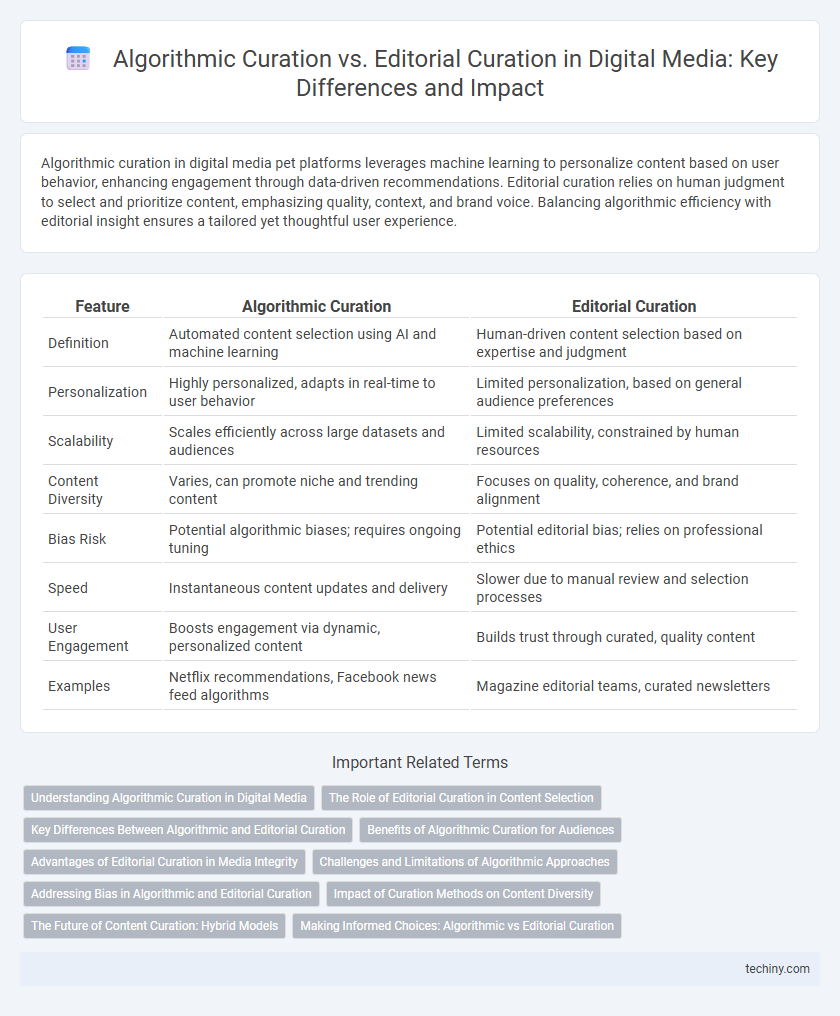Algorithmic curation in digital media pet platforms leverages machine learning to personalize content based on user behavior, enhancing engagement through data-driven recommendations. Editorial curation relies on human judgment to select and prioritize content, emphasizing quality, context, and brand voice. Balancing algorithmic efficiency with editorial insight ensures a tailored yet thoughtful user experience.
Table of Comparison
| Feature | Algorithmic Curation | Editorial Curation |
|---|---|---|
| Definition | Automated content selection using AI and machine learning | Human-driven content selection based on expertise and judgment |
| Personalization | Highly personalized, adapts in real-time to user behavior | Limited personalization, based on general audience preferences |
| Scalability | Scales efficiently across large datasets and audiences | Limited scalability, constrained by human resources |
| Content Diversity | Varies, can promote niche and trending content | Focuses on quality, coherence, and brand alignment |
| Bias Risk | Potential algorithmic biases; requires ongoing tuning | Potential editorial bias; relies on professional ethics |
| Speed | Instantaneous content updates and delivery | Slower due to manual review and selection processes |
| User Engagement | Boosts engagement via dynamic, personalized content | Builds trust through curated, quality content |
| Examples | Netflix recommendations, Facebook news feed algorithms | Magazine editorial teams, curated newsletters |
Understanding Algorithmic Curation in Digital Media
Algorithmic curation in digital media leverages machine learning models and user data to personalize content delivery, optimizing engagement and retention by predicting preferences based on behavior patterns. Unlike editorial curation, which relies on human judgment and expertise to select content, algorithmic curation continuously adapts through real-time analysis of metrics such as click-through rates, session duration, and audience demographics. This scalability allows platforms like Netflix and Spotify to efficiently manage vast amounts of data, enhancing user experience by dynamically matching content with individual interests.
The Role of Editorial Curation in Content Selection
Editorial curation plays a critical role in content selection by prioritizing quality, relevance, and context, which algorithmic curation often overlooks. Editors apply human judgment to assess cultural trends, ethical considerations, and audience needs, ensuring a more nuanced and authentic user experience. This approach helps maintain content diversity and depth that purely algorithm-driven systems might fail to achieve.
Key Differences Between Algorithmic and Editorial Curation
Algorithmic curation leverages machine learning and data analytics to automatically select and personalize digital media content based on user behavior, preferences, and engagement metrics. Editorial curation relies on human expertise, judgment, and thematic goals to handpick and contextualize content, ensuring quality and relevance beyond algorithmic patterns. Key differences include scalability, with algorithms handling vast datasets efficiently, while editorial curation provides nuanced, subjective insights that algorithms may miss.
Benefits of Algorithmic Curation for Audiences
Algorithmic curation enhances content personalization by analyzing user behavior and preferences, delivering highly relevant digital media experiences. It enables real-time adaptation to audience interests, increasing engagement and satisfaction. This data-driven approach also scales efficiently, providing diverse content tailored to individual tastes without human bias.
Advantages of Editorial Curation in Media Integrity
Editorial curation upholds media integrity by prioritizing accuracy, context, and ethical standards in content selection, reducing the spread of misinformation often amplified by algorithmic curation. Human editors can apply critical judgment to ensure diverse perspectives and in-depth analysis, fostering trust and credibility with audiences. This approach supports responsible journalism, enhancing the reliability and quality of digital media content.
Challenges and Limitations of Algorithmic Approaches
Algorithmic curation in digital media faces challenges such as data biases, limited contextual understanding, and the risk of reinforcing echo chambers by prioritizing user engagement over content diversity. These algorithms often struggle to interpret nuanced cultural contexts and fail to account for ethical considerations, leading to potential misinformation and decreased content quality. Dependence on user behavior data can result in narrow content exposure, limiting audience discovery and undermining editorial discretion.
Addressing Bias in Algorithmic and Editorial Curation
Algorithmic curation leverages machine learning models and user data to personalize digital media content but often perpetuates biases related to data representation and feedback loops. Editorial curation depends on human judgment and expertise, which can introduce subjective biases influenced by cultural, social, or ideological perspectives. Addressing bias in both curation methods requires transparent algorithms, diverse editorial teams, and continuous evaluation to ensure equitable and inclusive content delivery.
Impact of Curation Methods on Content Diversity
Algorithmic curation in digital media leverages machine learning to personalize content streams, often prioritizing user engagement metrics that can limit exposure to diverse perspectives. Editorial curation involves human judgment to select and present varied content, fostering a broader representation of viewpoints and topics. The impact on content diversity is significant, with editorial curation generally promoting richer diversity, while algorithmic curation risks creating echo chambers through reinforcement of existing preferences.
The Future of Content Curation: Hybrid Models
Hybrid content curation models combine algorithmic precision with editorial expertise to enhance digital media personalization and relevance. Leveraging machine learning algorithms enables real-time data analysis and trend identification, while human editors ensure contextual accuracy and nuanced storytelling. This synergy addresses the limitations of pure algorithmic or editorial approaches, driving more engaging and trustworthy content experiences.
Making Informed Choices: Algorithmic vs Editorial Curation
Algorithmic curation leverages data-driven insights and user behavior patterns to personalize digital media content at scale, enhancing engagement through predictive analytics. Editorial curation relies on expert judgment and thematic coherence, prioritizing quality and contextual relevance over quantity. Making informed choices between these methods requires evaluating factors such as audience purpose, content diversity, and the balance between automation efficiency and human oversight.
algorithmic curation vs editorial curation Infographic

 techiny.com
techiny.com